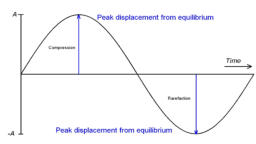

Corey Bailey
Audio Engineering
USEFUL INFORMATION
A LITTLE ABOUT SOUND
While very few of us actually think about how we hear sounds,
a basic understanding of how sound gets transmitted through the atmosphere
and subsequently heard by humans is useful.
Here is a somewhat oversimplified explanation;
Imagine whistling a single note. What happens is that air being exhaled fills the
space inside your mouth and passes through your parsed lips. Put another way;
Your cheeks and your parsed lips act as a resonator.
The resulting turbulence is pressure waves that exhale from your parsed lips.
For each high pressure wave, there is a low pressure wave just behind it. Each
high pressure wave and subsequent low pressure wave constitutes a cycle.
If a person is whistling a Concert Pitch ‘A’ note, they are creating 440 cycles per
second (or Hertz).
Because each cycle is created
over time, the rise and fall from
zero (no pressure) to high, back to
zero, then to the low pressure
zone and back to zero pressure
creates what is known as a sine
wave.
Our ear drums respond (vibrate, actually) to the changes in air pressure, and
those vibrations are then converted into tiny electrical signals and transmitted to
our brain via our nervous system.
Now, imagine that someone is standing on a stage whistling a single (A) note
into a microphone. The microphone works somewhat like the ear drum and
converts the pressure waves into tiny electrical pluses and minuses. Those tiny
electrical signals are then amplified about a thousand times by the sound system
amplifiers, and the resultant voltage is applied to loudspeakers. If the PA system
is connected correctly, every high and low pressure wave created by the whistler
is faithfully reproduced by the loudspeakers and the audience hears the changes
in air pressure from a hundred feet away or so, as if they were seated in front of
the whistler.
If you were to tap into
the amplified voltage at
any point in the PA
system and display it
on an oscilloscope,
(Right) you would
observe a sine wave!
What I have just described can be divided into two categories:
LIVE SOUND
Is the experience of listening to the whistler without any electrical amplification.
ANALOG AUDIO
The PA system; It converted the Live Sound into electrical signals and back
again to pressure waves via the loudspeakers.
Records, audio tape and digital files are some examples of storage methods
used for Live Sound or Analog Audio that is converted to electrical signals and
ultimately into amplified sound by your home stereo equipment.
Return to TOP of page
© Corey Bailey Audio Engineering
DO IT YOURSELF?
ANALOG TAPE
BAKING AUDIO TAPE
LUBRICATING AUDIO TAPE
MOISTURIZING ACETATE
TAPE
RECORDS (DISCS)
RECORD CLEANING
REPAIRING A BROKEN 78
FLATTENING A RECORD
ARTICLES
A Little About Sound
Baileyzone
Bit Depth
Conductive Paint
Mold
Optimizing your PC
Packing Records for
Shipment
People I have Known
Playing Records Wet
Playing a Wire Recording
Sample Frequency
Saving Your Family Video
SSD’s
The Alley
The Internet
The Ken Slater Tapes
Time Charts
Transfer Stories
Tubes vs Transistors
What Type of Wire?
Your Digital Data is at Risk

Image courtesy of: JISC digital media, UK










